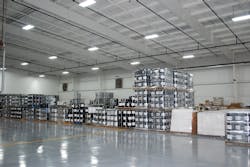According to a recent NRCA Town Hall, “The current supply shortage squeezing the roofing industry is the culmination of several factors, and not likely to end anytime soon.”
There are a number of speculative reasons for the global supply chain issues. While the causes might differ slightly from one list to another, the following are commonly found on just about every list.
- The pandemic seems to be at the top of most lists. It’s no surprise that the pandemic has had a negative effect on supply and demand of so many materials and finished products. Earlier in the pandemic, it seemed overall there was supply with little demand, and now a few years later, there is demand with little supply.
- The chip shortage is another common fault for the supply shortage. With many people hunkering down at home during the pandemic, there was a big increase in demand for technology items, so purchases soared. Closed factories—also because of the pandemic—decreased output, and the combination of the two started the downward slide. This shortage was even further exasperated by additional challenges with weather and shipping.
- The fire at an International Terminals Company (ITC) plant in Texas was bad enough, but the ensuing spill of fuel, water and fire-smothering material into a shipping canal leading to the Gulf of Mexico ended up closing a port and making the supply shortage even worse.
- Many industries are experiencing a workforce shortage, including the transportation industry. The American Trucking Associations (ATA), which represents the industry’s largest carriers, recently reported a shortage of 80,000 truck drivers in the United States.
- Port congestion is another culprit. A lack of movement of goods in and out of U.S. ports has created record numbers of shipping vessels to be halted in the water. Furthermore, port terminals are extremely overcrowded with shipping containers with nowhere for them to go because of a lack of available warehouse space.
[Related: These Trends are Making a Mark on HVAC]
What is the Impact on Roofing?
The supply chain issues have negatively impacted many industries, including the roofing industry. Contractors are feeling the effects with delayed shipments of roofing products, such as adhesives, ISO boards, plates, fasteners, screws and various roofing membranes.
Insulation, one of the main materials used in roofing, is common in both new roof construction and re-roofing. Insulation is used in achieving thermal resistance and in some cases a recovery board for the new roof system. R-values may range from R-20 to R-40, depending upon the geographic area and usage of the facility. Multiple layers of insulation are often used to meet these R-values. New energy codes, found especially in new roof construction, many times require the insulation to finish the project. These requirements further strain the current shortage of material.
Roof membrane shortages are making alternatives to roof replacements even more attractive. Some of these alternatives, such as roof restorations, do not require insulation and can offer long-term warranties.
What’s to Blame?
Texas experienced an unprecedented deep freeze last year. Being home to many major chemical plants, the production of methylene diphenyl diisocyanate (MDI) that is used for roofing insulation/ISO boards took a hit when the product got stuck in the frozen pipeline. As with any halt in production, the effects on inventory can be long term.
The wires made for fasteners, screws and roofing plates have also been impacted by port congestion, as well as by a labor shortage in U.S. steel plants causing second and third shifts to be compromised or nonexistent.
Add to that a shortage of qualified workers, and many throughout the roofing industry are referring to it as a perfect storm.
[Related: Supporting Life Safety and the Plenum]
What Can Be Done?
Building owners, property managers and facility executives are beyond frustrated. They know prolonging roof remedies on leaking roofs is a disaster—or disasters—waiting to happen. This lack of action is risking damaged goods, equipment and inventory, not to mention jeopardizing a loss of customers and employees. Fortunately, there’s no need to feel helpless—even in today’s conundrum.
- Establishing a relationship with a trusted roofing company who has an inventory of materials has never been more important. As with practically any business, if they’re on your A-list, chances are you’ll be on their A-list.
- It takes no roofing materials for your roofing company to do testing and analysis. This should be conducted as a first step so that both of you can truly understand your roof’s condition, and best possible solutions customized to meet your requirements can be uncovered.
- Ask to lock in pricing for a specified period of time. Beware of proposals that state pricing is not being secured until materials ship. This could amount to a large change order down the road and make it difficult to compare the current bids.
These are challenging times for sure, but you can lessen the stress by surrounding yourself with roofing companies that understand the importance of managing their supply chain and staying ahead of trends and forecasts. This will not only reduce your frustration, but it will also resolve your roofing problems more quickly and effectively.
About the Author:
Michael Dohar is the Chief Operating Officer of Simon Roofing. His areas of expertise are operations and administration, including supply chain management.
Read next: How to Save Money with Code-Compliant Roof Replacements
About the Author

Contributed Author
BUILDINGS partners with industry experts to bring you contributed content covering the hot topics for building owners and facility professionals.
